
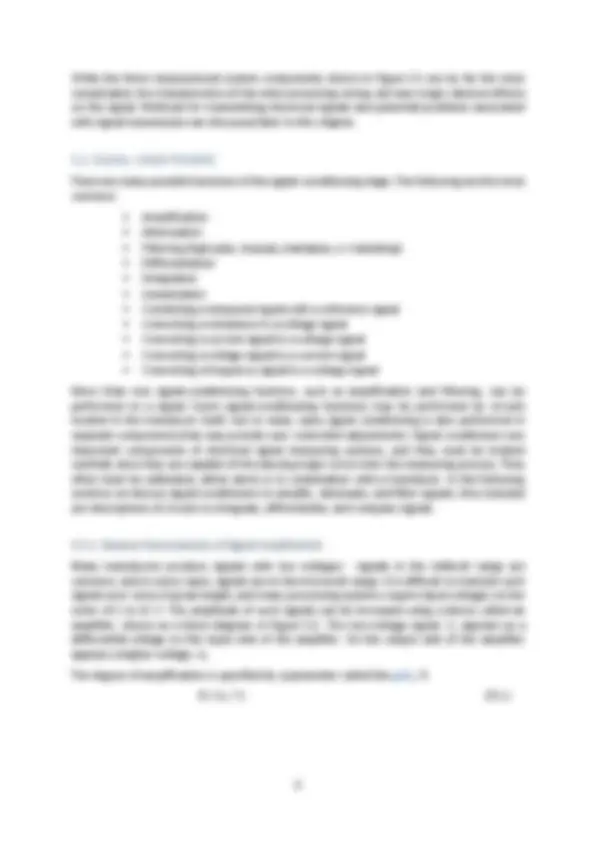
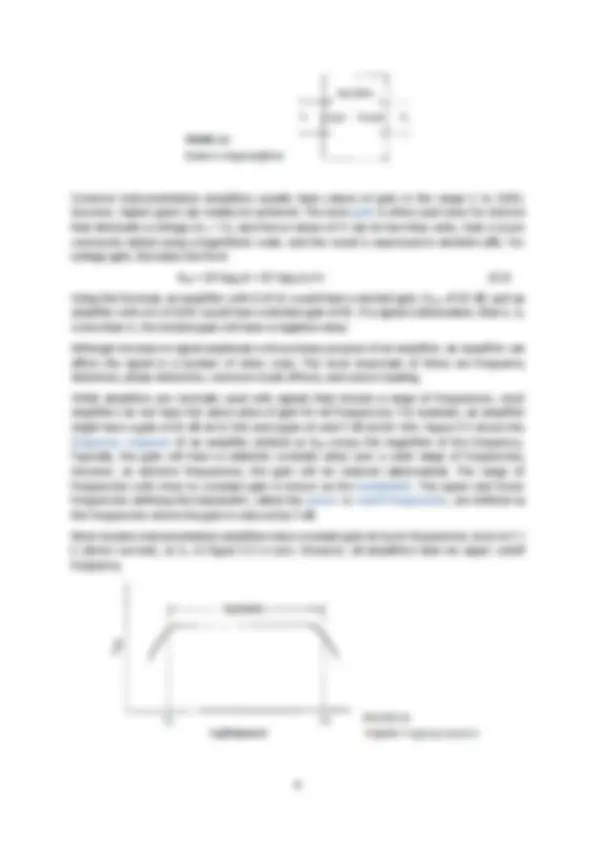
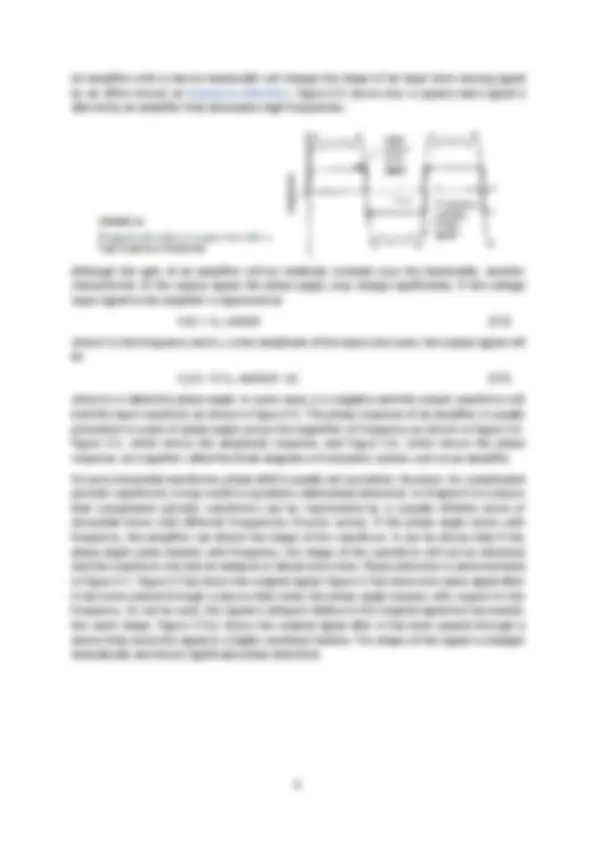
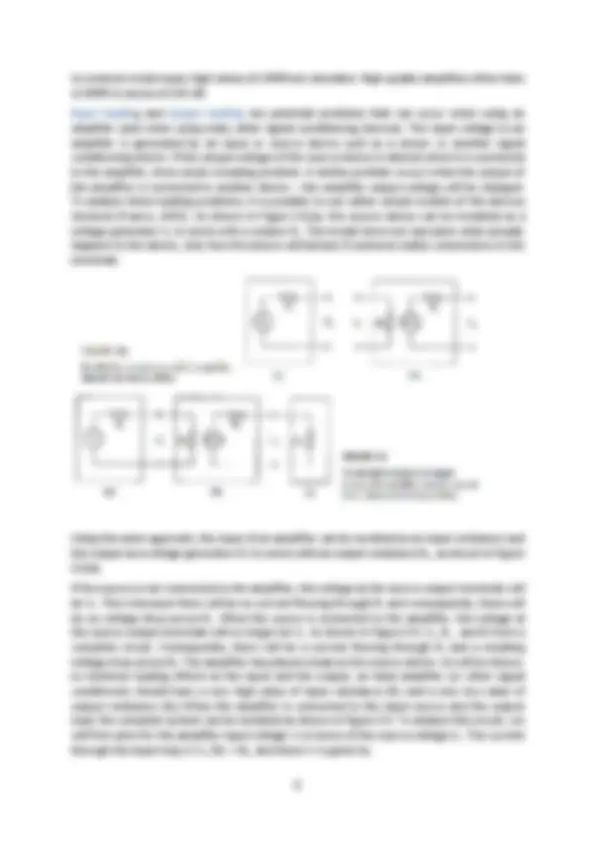
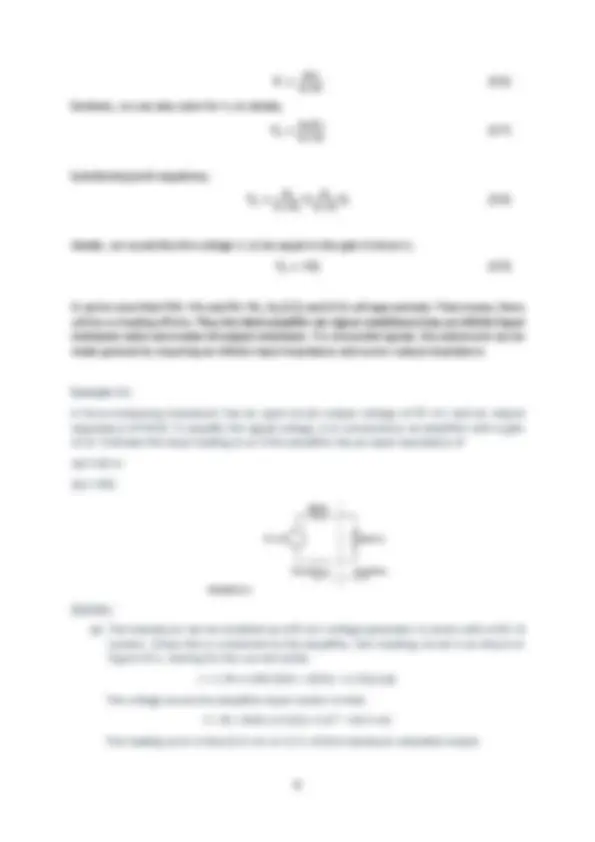
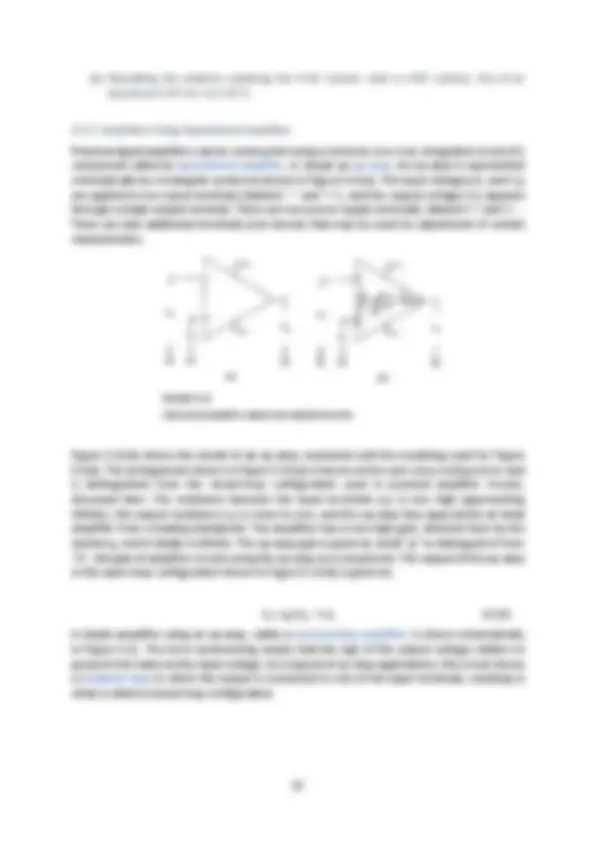


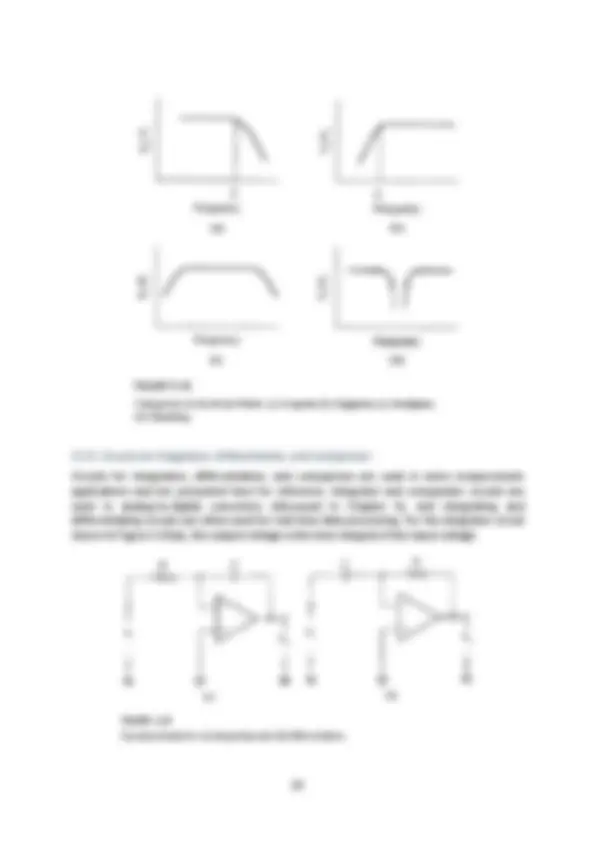
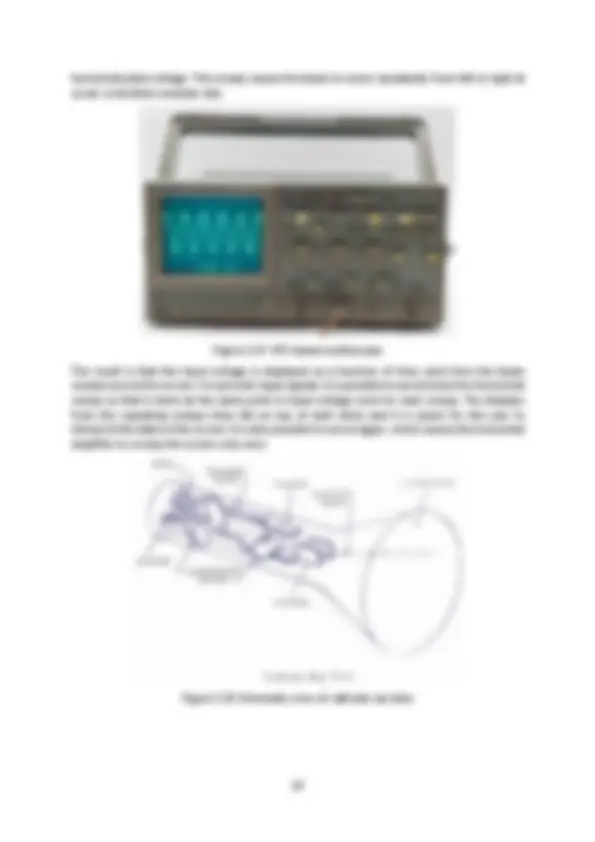
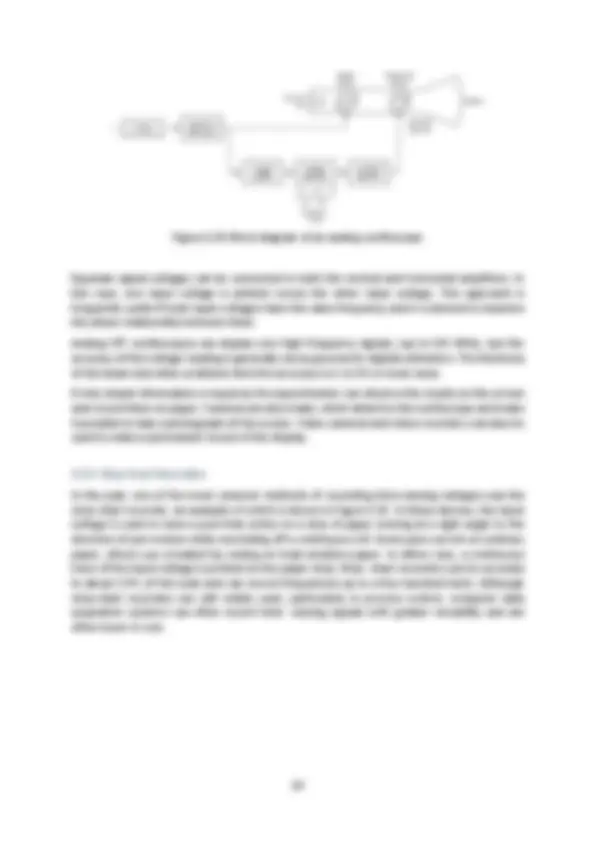
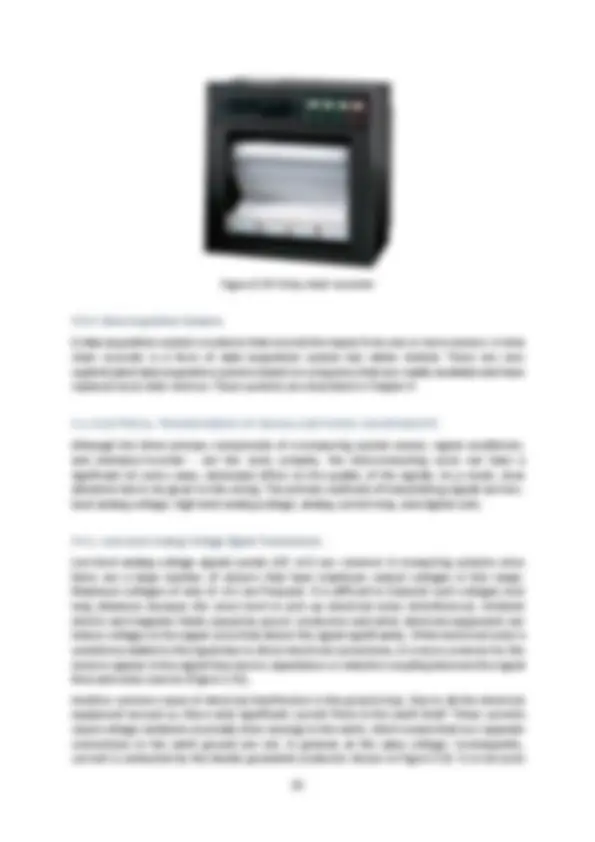
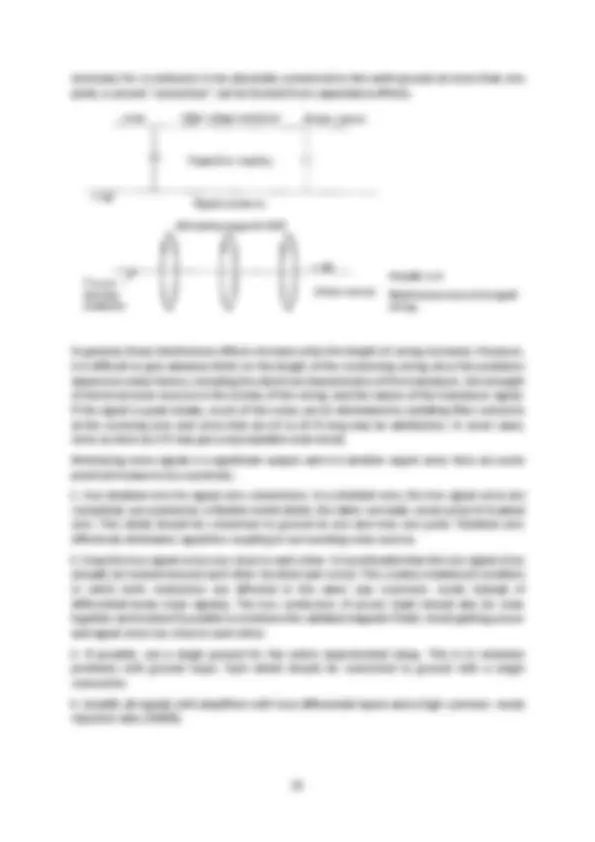
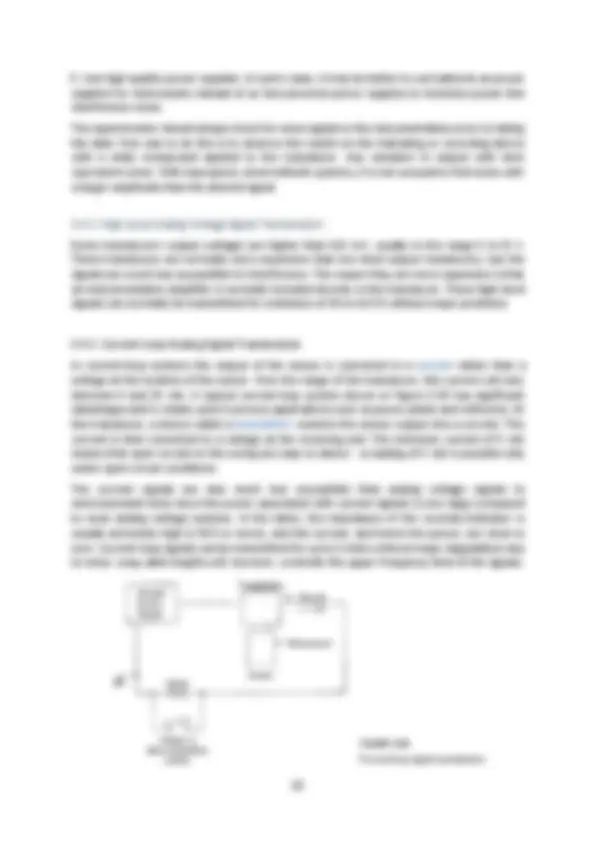



Study with the several resources on Docsity

Earn points by helping other students or get them with a premium plan


Prepare for your exams
Study with the several resources on Docsity

Earn points to download
Earn points by helping other students or get them with a premium plan
Community
Ask the community for help and clear up your study doubts
Discover the best universities in your country according to Docsity users
Free resources
Download our free guides on studying techniques, anxiety management strategies, and thesis advice from Docsity tutors
Electrical signal measuring systems, focusing on amplification and filtering techniques. Electrical signals are commonly used in measurement systems due to their advantages over mechanical systems. Various methods for transmitting electrical signals and potential problems, including amplification, attenuation, filtering, differentiation, integration, linearization, and converting signals. The document also discusses the importance of signal conditioners and their potential errors. Examples are provided to illustrate the concepts.
Typology: Summaries
1 / 23

This page cannot be seen from the preview
Don't miss anything!
















Measuring systems that use electrical signals to transmit information between components have substantial advantages over completely mechanical systems and consequently are very widely used. In this chapter, we describe common aspects of electrical-signal measuring systems.
Almost all modern engineering measurements can be made using sensing devices that have an electrical output. This means that an electrical property of the device is caused to change
by the measurand, either directly or indirectly. Most commonly, the measurand causes a change in a resistance, capacitance, or voltage. In some cases, however, the output of the sensor is a measurand-dependent current, frequency, or electric charge. Electrical output sensing devices have several significant advantages over mechanical devices:
Common instrumentation amplifiers usually have values of gain in the range 1 to 1000; however, higher gains can readily be achieved. The term gain is often used even for devices that attenuate a voltage (Vo < Vi), and hence values of G can be less than unity. Gain is more commonly stated using a logarithmic scale, and the result is expressed in decibels (dB). For voltage gain, this takes the form GdB = 20 log 10 G = 20 log 10 Vo/Vi (3.2) Using this formula, an amplifier with G of 10 would have a decibel gain, GdB, of 20 dB, and an amplifier with a G of 1000 would have a decibel gain of 60. If a signal is attenuated, that is, Vo is less than Vi, the decibel gain will have a negative value. Although increase in signal amplitude is the primary purpose of an amplifier, an amplifier can affect the signal in a number of other ways. The most important of these are frequency distortion, phase distortion, common-mode effects, and source loading. While amplifiers are normally used with signals that include a range of frequencies, most amplifiers do not have the same value of gain for all frequencies. For example, an amplifier might have a gain of 20 dB at 10 kHz and a gain of only 5 dB at 100 kHz. Figure 3.3 shows the frequency response of an amplifier plotted as GdB versus the logarithm of the frequency. Typically, the gain will have a relatively constant value over a wide range of frequencies; however, at extreme frequencies, the gain will be reduced (attenuated). The range of frequencies with close to constant gain is known as the bandwidth. The upper and lower frequencies defining the bandwidth, called the corner or cutoff frequencies , are defined as the frequencies where the gain is reduced by 3 dB. Most modem instrumentation amplifiers have constant gain at lower frequencies, even to f = 0 (direct current), so fc1 in Figure 3.3 is zero. However, all amplifiers have an upper cutoff frequency.
An amplifier with a narrow bandwidth will change the shape of an input time-varying signal by an effect known as frequency distortion. Figure 3.4 shows how a square-wave signal is altered by an amplifier that attenuates high frequencies. Although the gain of an amplifier will be relatively constant over the bandwidth, another characteristic of the output signal, the phase angle, may change significantly. If the voltage input signal to the amplifier is expressed as Vi(t) = Vmi sin2 ft (3.3) where f is the frequency and Vmi is the amplitude of the input sine wave, the output signal will be Vo(t) = G Vmi sin(2 ft + ) (3.4) where is called the phase angle. In most cases, is negative and the output waveform will trail the input waveform as shown in Figure 3.5. The phase response of an amplifier is usually presented in a plot of phase angle versus the logarithm of frequency as shown in Figure 3.6. Figure 3.3, which shows the amplitude response, and Figure 3.6, which shows the phase response, are together called the Bode diagrams of a dynamic system such as an amplifier. For pure sinusoidal waveforms, phase shift is usually not a problem. However, for complicated periodic waveforms, it may result in a problem called phase distortion. In Chapter 5 it is shown that complicated periodic waveforms can be represented by a (usually infinite) series of sinusoidal terms with different frequencies (Fourier series). If the phase angle varies with frequency, the amplifier can distort the shape of the waveform. It can be shown that if the phase angle varies linearly with frequency, the shape of the waveform will not be distorted and the waveform will only be delayed or advanced in time. Phase distortion is demonstrated in Figure 3.7. Figure 3.7(a) shows the original signal. Figure 3.7(b) shows the same signal after it has been passed through a device that varies the phase angle linearly with respect to the frequency. As can be seen, the signal is delayed relative to the original signal but has exactly the same shape. Figure 3.7(c) shows the original signal after it has been passed through a device that varies the signal in a highly nonlinear fashion. The shape of the signal is changed dramatically and shows significant phase distortion.
Another important characteristic of amplifiers is known as common-mode rejection ratio (CMRR). When different voltages are applied to the two input terminals (Figure 3.2), the input is known as a differential-mode voltage. When the same voltage (relative to ground) is applied to the two input terminals, the input is known as a common-mode voltage. An ideal instrumentation amplifier will produce an output in response to differential-mode voltages but will produce no output in response to common-mode voltages. Real amplifiers will produce an output response to both differential- and common-mode voltages, but the response to differential-mode voltages will be much larger. The measure of the relative response to differential- and common mode voltages is described by common-mode rejection ratio, defined by CMRR = 20 log 10 Gdiff/Gcm (3.5) and is expressed in decibels. Gdiff is the gain for a differential-mode voltage applied between the input terminals, and Gcm is the gain for a common-mode voltage applied to both terminals. Since signals of interest usually result in differential-mode input and noise signals often result
in common-mode input, high values of CMRR are desirable. High-quality amplifiers often have a CMRR in excess of 100 dB. Input loadin g and output loading are potential problems that can occur when using an amplifier (and when using many other signal-conditioning devices). The input voltage to an amplifier is generated by an input or source device such as a sensor or another signal conditioning device. If the output voltage of the source device is altered when it is connected to the amplifier, there exists a loading problem. A similar problem occurs when the output of the amplifier is connected to another device – the amplifier output voltage will be changed. To analyze these loading problems, it is possible to use rather simple models of the devices involved (Franco, 2002). As shown in Figure 3.8(a), the source device can be modeled as a voltage generator Vs in series with a resistor Rs. This model does not represent what actually happens in the device, only how the device will behave if someone makes connections to the terminals. Using the same approach, the input of an amplifier can be modeled as an input resistance and the output as a voltage generator GVi in series with an output resistance Ro, as shown in Figure 3.8(b). If the source is not connected to the amplifier, the voltage at the source output terminals will be Vs. This is because there will be no current flowing through Rs and consequently, there will be no voltage drop across Rs. When the source is connected to the amplifier, the voltage at the source output terminals will no longer be Vs. As shown in Figure 3.9, Vs, Rs , and Ri form a complete circuit. Consequently, there will be a current flowing through Rs and a resulting voltage drop across Rs. The amplifier has placed a load on the source device. As will be shown, to minimize loading effects at the input and the output, an ideal amplifier (or other signal conditioner) should have a very high value of input resistance (Ri) and a very low value of output resistance (Ro)·When the amplifier is connected to the input source and the output load, the complete system can be modeled as shown in Figure 3.9. To analyze this circuit, we will first solve for the amplifier input voltage Vi in terms of the source voltage Vs. The current through the input loop is Vs /(Rs + Ri), and hence Vi is given by
(b) Repeating the analysis replacing the 4-kO resistor with a I-MO resistor, the error becomes 0.047 mV or 0.05 %. 3.2.2. Amplifiers Using Operational Amplifiers Practical signal amplifiers can be constructed using a common, low-cost, integrated circuit (IC) component called an operational amplifier , or simply an op-amp. An op-amp is represented schematically by a triangular symbol as shown in Figure 3.10(a). The input voltages (Vn and Vp) are applied to two input terminals (labeled "-" and "+"), and the output voltage (Vo) appears through a single output terminal. There are two power supply terminals, labeled V + and V -. There are also additional terminals (not shown) that may be used for adjustment of certain characteristics. Figure 3.10(b) shows the model of an op-amp consistent with the modeling used for Figure 3.8(b). The arrangement shown in Figure 3.1 0 (a) is known as the open-loop configuration and is distinguished from the closed-loop configuration used in practical amplifier circuits, discussed later. The resistance between the input terminals (rd) is very high (approaching infinity), the output resistance (ro) is close to zero, and the op-amp thus approaches an ideal amplifier from a loading standpoint. The amplifier has a very high gain, denoted here by the symbol g, which ideally is infinite. The op-amp gain is given by small “g” to distinguish it from “G”, the gain of amplifier circuits using the op-amp as a component. The output of the op-amp in the open-loop configuration shown in Figure 3.1 0 (b) is given by: Vo = g (Vp – Vn) (3.10) A simple amplifier using an op-amp, called a noninverting amplifier , is shown schematically in Figure 3.11. The term noninverting means that the sign of the output voltage relative to ground is the same as the input voltage. As is typical of op-amp applications, this circuit shows a feedback loop in which the output is connected to one of the input terminals, resulting in what is called a closed-loop configuration.
The structure of the feedback loop is used to determine the characteristics of op-amp-based devices. In the noninverting amplifier, the feedback voltage is connected to the minus input terminal and the signal input to the plus terminal. Referring to Figure 3.10(b), the + terminal voltage Vp is then simply Vi. To obtain the voltage Vm we will analyze the circuit that includes Vo, R 2 , R 1 and the ground. The current flow from point B into the op-amp negative terminal will be small due to the high op-amp input impedance and will be neglected. Analyzing the circuit, the current through resistor R 1 , IR1 is Vo / (R 1 + R 2 ), and the voltage Vn = VB = IR1R 1 is found to be 𝑉𝑛 = 𝑉𝑜 𝑅 1 𝑅 1 +𝑅 2
Substituting these input voltages (Vp and Vn) into Eq. (3.10), we get: 𝑉𝑜 = 𝑔(𝑉𝑝 − 𝑉𝑛) = 𝑔(𝑉𝑖 − 𝑉𝑜 𝑅 1 𝑅 1 +𝑅 2
Solving for Vo, we obtain: 𝑉𝑜 = 𝑔𝑉𝑖 1 +𝑔[𝑅 1 /(𝑅 1 +𝑅 2 )]
For the op-amp, g is very large and the second term in the denominator of Eq. (3.13) is very large compared to 1. With this approximation and noting that the gain for the amplifier is G = Vo/Vi, Eq. (3.13) can be solved to give: G = 𝑉𝑜 𝑉𝑖
𝑅 1 +𝑅 2 𝑅 1
𝑅 2 𝑅 1
The gain is found to be a function only of the ratio R 2 /R 1 and does not depend on the actual resistor values. Values of R 1 and R 2 in the range 1 kΩ to 1 MΩ are typical. Resistances above 1 MΩ complicate circuit design because stray capacitance effects alter the impedance. Low resistance values lead to high power consumption. In some circuits high resistance values and specialized op-amps are required which is beyond the scope of this course. It should be noted that if Vi is high enough so that Vo (= GVi) approaches the power supply voltage, further increases in Vi will not increase the output. This situation is called output saturation.
This problem can be avoided by having the sum of resistors R 1 and R 2 be very high compared to the output impedance of the system generating Vi. Unfortunately, this means that the output resistance of the network, R 2 , will also be high, leading to a problem when the output load is connected. It may be desirable to feed the voltage divider output into a high-input impedance amplifier with unity gain to reduce output loading problems. The effect of loading is evaluated in Example 3.3. The use of large values of resistance in voltage dividers presents another problem in addition to loading. At high signal frequencies, the impedance due to small amounts of capacitance can be comparable to the divider resistances and can produce attenuation that is frequency dependent. Example 3. The voltage used to power a heater in an experiment is nominally 120 V. To record this voltage, it must first be attenuated using a voltage divider. The attenuator reduces the voltage by a factor of 15 and the sum of the resistors R 1 and R 2 is 1000 Ω. (a) Find R 1 and R 2 and the ideal voltage output (neglecting loading effects). (c) If the source resistance Rs is 1Ω, find the actual divider output Vo and the resulting loading error in Vo. (d) If the divider output is connected to a recorder that has an input impedance of 5000 Ω, what will be the voltage output (input to the recorder) and the resulting loading error? Solution: (a) Using Eq. (3.19); 𝑉𝑜 𝑉𝑖
1 15
𝑅 2 𝑅 1 +𝑅 2
𝑅 2 1000 R 2 = 66. R 1 = 1000 – R 2 = 933. The nominal voltage is 120/15=8 V (b) The circuit of the complete system, including the source impedance, is shown in Figure E3.3(a). Solving for the current in the loop gives I = V /(R) = 120 / (1+933.3 + 66.7) = 0.1199 A We can then evaluate the output voltage: Vo = I R 2 = 0.1199 x 66.7 = 7.997 V
The error is thus 0.003V or 0.4%. (c) If we connect the divider output to a recorder with an input impedance of 5000 , we will have the circuit shown in Figure E3.3(b). R2 and Ri are resistors in parallel, which can be combined to give a value of 65.8 . Solving for the loop current; I = V /(R) = 120 / (1+933.3 + 65.8) = 0.120 A Vo = I R =0.1200 x 65.8 = 7.9 A This is a loading error of 0.10 V or 1.3%. Comments : The primary loading problem was the rather low input impedance of the recorder. In this case R 2 could be adjusted slightly using a calibration process to eliminate the loading error. Alternatively, an amplifier with a high input impedance, such as the noninverting type described in Section 3.2.2 but with unity gain, could be placed between the divider and recorder to eliminate the loading problem. The loading error could be reduced somewhat by reducing the sum R 1 + R 2 ; however, this would raise the power dissipated in these resistors, which is already about 14W. 3.2.4. General Aspects of Signal Filtering In many measuring situations, the signal is a complicated, time-varying voltage that can be considered to be the sum of many sine waves of different frequencies and amplitudes. It is often necessary to remove some of these frequencies by a process called filtering. There are two very common situations in which filtering is required. The first is the situation in which there is spurious noise (such as 60-Hz power-line noise) imposed on the signal. The second occurs when a data acquisition system samples the signal at discrete times (rather than continuously). In the latter case, filtering is necessary to avoid a serious problem called aliasing. A filter is a device by which a time-varying signal is modified intentionally, depending on its frequency. Filters are normally broken into four types: lowpass, high- pass, bandpass, and bandstop filters. The characteristics of these categories of filters are shown in Figure 3.16. A lowpass filter allows low frequencies to pass without attenuation but, starting at a frequency fc called the corner frequency , attenuates higher- frequency components of the signal. The frequency band with approximately constant gain (Vo/Vi) between f = 0 and fc is known as the passband. The significantly attenuated frequency range is known as the stopband. The region between fc and the stop- band is known as the transition band. A highpass filter allows high frequency to pass but attenuates low frequencies. A bandpass filter attenuates signals at both high and low frequencies but allows a range of frequencies to pass without attenuation. Finally, a bandstop filter allows both high and low frequencies to pass but attenuates an intermediate band of frequencies. If the band of stopped frequencies is very narrow, the bandstop filter is called a notch filter. Although a very large number of circuits function as filters, four classes of filters are most widely used: Butterworth, Chebyshev, elliptic, and Bessel. Each filter class has unique characteristics that makes it the most suitable for a particular application. Each of these filter classes can have another characteristic, called order. For a particular filter class, the higher the order, the greater will be the attenuation of the signal in the stopband.
For the differentiator circuit shown in Figure 3.24(b), the output voltage is the time derivative of the input voltage: Figure 3.25 shows a simple circuit for an open-loop op-amp voltage comparator. In this circuit the input voltage is compared to a reference voltage Vref. If the input voltage is greater than the reference voltage (Vi > Vref) , the output voltage is saturated at about 2 V less than the power supply positive voltage. If the input voltage is less than the reference voltage (Vi < Vref), the output voltage will saturate at close to 2 V higher than the negative power supply voltage.
3.3.1. Digital Voltmeters and Multimeters In most cases the output of the signal conditioner is an analog voltage. If the user only wishes to observe the voltage and the voltage is quasi-steady, a simple digital voltmeter (DVM) is the best choice of indicating device. Figure 3.26 shows a typical hand-held digital multimeter (DMM), which has a DVM as one of its functions. Modern digital voltmeters have a very high input impedance (in the megaohm range), so the voltage measurement process will not usually affect the voltage being measured. An important component of a digital voltmeter is an analog-to-digital (A/D) converter, which converts the input analog voltage signal to a digital code that can be used to operate the display. Relatively inexpensive digital voltmeters can have an accuracy of better than 1% of reading, and high- quality voltmeters can be significantly better.
Figure 3.26 hand-held digital multimeter (DMM) Digital multimeters can be used to display other types of input signals, such as current or resistance or frequency. Some can even input and display signals that are already in digital form. It is common in the process control industry to combine a digital voltmeter with a signal conditioner. In this case it is called a digital panel meter (DPM). The DPM displays the conditioned signal to assist in adjusting the conditioner while the signal is also transmitted to a central computer data acquisition and control system. 3.3.2. Oscilloscopes If the output of a sensor is varying rapidly, a digital voltmeter is not a suitable indicating device and an oscilloscope (scope) is more appropriate. Historically, oscilloscopes have used analog circuitry and a Cathode Ray Tube (CRT), which is an accurately constructed version of the old television picture tube. CRT-based oscilloscopes are still widely used in laboratories, but modern digital storage scopes with solid state displays are now becoming the norm. Digital storage scopes are based on computer components and are discussed in Chapter 4. Here, the older CRT scopes will be described. In this device, pictured in Figure 3.27, the voltage output of the signal conditioner is used to deflect the electron beam in the CRT. The CRT, which is shown schematically in Figure 3.28, consists of a heated cathode that generates free electrons, an anode which is used to accelerate an electron beam, two sets of deflection plates, and a front face (screen), which is coated with phosphors. When voltages of suitable amplitude are applied to the deflection plates, the electron beam will be deflected and hence will cause the phosphors to glow at a particular position on the screen. The visible deflection is proportional to the input voltage. A block diagram of the basic circuit elements used to control the CRT is shown in Figure 3.29. Normally, the input voltage to be displayed is connected to the amplifier that controls the vertical plate voltage. A sweep generator is connected to the amplifier controlling the
Figure 3.29 Block diagram of an analog oscilloscope Separate signal voltages can be connected to both the vertical and horizontal amplifiers. In this case, one input voltage is plotted versus the other input voltage. This approach is frequently useful if both input voltages have the same frequency and it is desired to examine the phase relationship between them. Analog CRT oscilloscopes can display very high frequency signals, (up to 100 MHz), but the accuracy of the voltage reading is generally not as good as for digital voltmeters. The thickness of the beam and other problems limit the accuracy to 1 to 2% in most cases. If only simple information is required, the experimenter can observe the results on the screen and record them on paper. Cameras are also made, which attach to the oscilloscope and make it possible to take a photograph of the screen. Video cameras and video recorders can also be used to make a permanent record of the display. 3.3.3. Strip-Chart Recorders In the past, one of the most common methods of recording time-varying voltages was the strip-chart recorder, an example of which is shown in Figure 3.30. In these devices, the input voltage is used to move a pen that writes on a strip of paper moving at a right angle to the direction of pen motion while unwinding off a continuous roll. Some pens use ink on ordinary paper, others use a heated tip resting on heat-sensitive paper. In either case, a continuous trace of the input voltage is printed on the paper strip. Strip- chart recorders can be accurate to about 0.5% of full scale and can record frequencies up to a few hundred hertz. Although strip-chart recorders are still widely used, particularly in process control, computer data acquisition systems can often record time- varying signals with greater versatility and are often lower in cost.
Figure 3.30 Strip chart recorder 3.3.4. Data Acquisition Systems A data acquisition system is a device that records the inputs from one or more sensors. A strip chart recorder is a form of data acquisition system but rather limited. There are now sophisticated data acquisition systems based on computers that are readily available and have replaced most older devices. These systems are described in Chapter 4.
Although the three primary components of a measuring system-sensor, signal conditioner, and indicator/recorder - are the most complex, the interconnecting wires can have a significant (in some cases, dominant) effect on the quality of the signals. As a result, close attention has to be given to this wiring. The primary methods of transmitting signals are low- level analog voltage, high-level analog voltage, analog current loop, and digital code. 3.4.1. Low-Level Analog Voltage Signal Transmission Low-level analog voltage signals (under 100 mV) are common in measuring systems since there are a large number of sensors that have maximum output voltages in this range. Maximum voltages of only 10 mV are frequent. It is difficult to transmit such voltages over long distances because the wires tend to pick up electrical noise (interference). Ambient electric and magnetic fields caused by power conductors and other electrical equipment can induce voltages in the signal wires that distort the signal significantly. While electrical noise is sometimes added to the signal due to direct electrical connections, it is more common for the noise to appear in the signal lines due to capacitance or inductive coupling between the signal lines and noise sources (Figure 3.31). Another common cause of electrical interference is the ground loop. Due to all the electrical equipment around us, there exist significant current flows in the earth itself. These currents cause voltage variations (normally time varying) in the earth, which means that two separate connections to the earth ground are not, in general, at the same voltage. Consequently, current is conducted by the doubly grounded conductor shown in Figure 3.32. It is not even